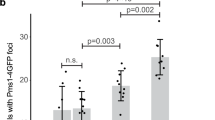Summary
The induction of gene conversion and mitotic crossing-over by photoaddition of psoralens, 254 nm ultraviolet radiation, and nitrogen mustards was determined in diploid cells homozygous for the pso3-1 mutation and in the corresponding wild type of Saccharomyces cerevisiae. For these different agents, the frequency of non-reciprocal events (conversion) is reduced in the pso3-1 mutant compared to the wild type. In contrast, the frequency of reciprocal events (crossing-over) is increased at a range of doses. These observations, together with the block in induced mutagenesis for both reverse and forward mutations previously reported for the pso3-1 mutant, suggest that the PS03 gene product plays a role in mismatch repair of short patch regions. The block in gene conversion in the pso3 homozygous diploid leads, in the case of nitrogen mustards, to specific repair intermediates which are lethal to the cells.
Similar content being viewed by others
References
Andrade HHR, Marques EK, Schenberg ACG, Henriques JAP (1989) The PS04 gene is responsible for an error-prone recombinational DNA repair pathway in Saccharomyces cerevisiae. Mol Gen Genet 217:419–426
Averbeck D, Moustacchi E (1975) 8-Methoxypsoralen plus 365 nm light effects and repair in yeast. Biochim Biophys Acta 395:393–404
Averbeck D, Moustacchi E, Bisagni E (1978) Biological effects and repair of damage photoinduced by a derivative of psoralen substituted at the 3,4 reaction site. Photoreactivity of this compound and lethal effects in yeast. Biochim Biophys Acta 518:464–481
Benfato MS (1989) Interacoes entre o gene PS03 e genes PSO and RAD apos fotoadicao de furocoumarinos a ao tratomento con radiacous UV de 254 nm. Thesis Universidade Federal do Rio Grande do Sul, Porto Alegre, Brazil
Brendel M, Ruhland A (1984) Relationships between functionality and genetic toxicology of selected DNA-damaging agents. Mutat Res 133:51–85
Cassier C, Moustacchi E (1981) Mutagenesis induced by monoand bi-functional alkylating agents in yeast mutants sensitive to photo-addition of furocoumarins (pso). Mutat Res 84:37–47
Cassier C, Chanet R, Henriques JAP, Moustacchi E (1980) The effects of three pso genes on induced mutagenesis: a novel class of mutationally defective yeast. Genetics 96:841–857
Cassier-Chauvat C, Moustacchi E (1988) Allelism between pso1-1 and rev3-1 mutants and between pso2-1 and snm1 mutants in Saccharomyces cerevisiae. Curr Genet 13:37–40
Friedberg EC (1988) Deoxyribonucleic acid repair in the yeast Saccharomyces cerevisiae. Microbiol Rev 52:70–102
Game JC, Mortimer RK (1974) A genetic study of X-ray sensitive mutants in yeast. Mutat Res 24:281–292
Henriques JAP, Moustacchi E (1980a) Sensitivity to photo-addition of mono- and bi-functional furocoumarins of X-ray-sensitive mutants of Saccharomyces cerevisiae. Photochem Photobiol 31:555–562
Henriques JAP, Moustacchi E (1980b) Isolation and characterization of pso mutants sensitive to photo-addition of psoralen derivatives in Saccharomyces cerevisiae. Genetics 95:273–288
Henriques JAP, Vicente EJ, Da Silva KVCL, Schenberg ACG (1989) PS04: a novel gene involved in error-prone repair in Saccharomyces cerevisiae. Mutat Res (in press)
Jackson J, Fink G (1981) Gene conversion between duplicated genetic elements in yeast. Nature 292:306–311
Klein HL (1988) Different types of recombination events are controlled by the RAD1 and RAD2 genes of Saccharomyces cerevisiae. Genetics 120:367–377
Kunz B, Haynes R (1981) Phenomenology and genetic control of mitotic recombination in yeast. Annu Rev Genet 15:57–89
Lemontt JF (1971) Mutants of yeast defective in mutation induced by ultraviolet light. Genetics 68:21–33
Machida I, Nakai S (1980) Induction of spontaneous and UV-induced mutations during comitment to meiosis in Saccharomyces cerevisiae. Mutat Res 73:59–68
Magaña-Schweneke N, Averbeck D, Henriques JAP, Moustacchi E (1980) Absence de pontages inter-chaînes dans l'ADN traité par le 3-carbéthoxypsoralène et une irradiation à 365 nm. CR Acad Sci Paris 291:207–210
Malone RE, Esposito RE (1980) The RAD2 gene is required for homothallic interconversion of mating types and spontaneous mitotic recombination in yeast. Proc Natl Acad Sci USA 77:503–507
Moustacchi E (1987) DNA repair in yeast: genetic control and biological consequences. Adv Radiat Biol 13:1–30
Moustacchi E, Cassier C, Chanet R, Magaña-Schwencke N, Saeki T, Henriques JAP (1983) Biological role of photo-induced cross-links and monoadducts in yeast DNA: Genetic control and steps involved in their repair. In: Friedberg EC, Bridges BA (eds) Cellular responses to DNA damage. Liss, New York, pp 87–106
Parsons BJ (1980) Psoralen photochemistry. Photochem Photobiol 32:813–821
Prakash L, Taillon-Miller P (1981) Effects of the rad52 gene on sister chromatid recombination in Saccharomyces cerevisiae. Curr Genet 3:247–250
Prakash S, Prakash L, Burke W, Montelone BA (1980) Effects of the RAD52 gene on recombination in Saccharomyces cerevisiae. Genetics 94:31–50
Resnick MA, Martin P (1976) The repair of double-strand breaks in nuclear DNA of Saccharomyces cerevisiae and its genetic control. Mol Gen Genet 143:119–129
Ruhland A, Brendel M (1979) Mutagenesis by cytostatic alkylating agents in yeast strains of differing repair capacities. Genetics 92:83–97
Saeki T, Machida I, Nakai S (1980) Genetic control of diploid recovery after y-irradiation in the yeast Saccharomyces cerevisiae. Mutat Res 73:251–265
Saeki T, Cassier C, Moustacchi E (1983) Induction in Saccharomyces cerevisiae of mitotic recombination by mono- and bifunctional agents: comparison of the pso2-1 and rad52 repair deficient mutants to the wild type. Mol Gen Genet 190:255–264
Schiestl RH, Prakash S (1988) RAD1 an excision repair gene of Saccharomyces cerevisiae is also involved in recombination. Mol Cell Biol 8:3619–3626
Song PS, Tapley KJ (1979) Photochemistry and photobiology of psoralens. Photochem Photobiol 29:1177–1197
Szostak JW, Orr-Weaver TL, Rothstein RJ, Stahl FW (1983) The double strand break repair model for recombination. Cell 33:25–35
Willis KK, Klein HL (1987) Intrachromosomal recombination in Saccharomyces cerevisiae: reciprocal exchange in an inverted repeat and associated gene conversion. Genetics 117:633–643
Author information
Authors and Affiliations
Additional information
Communicated by W. Gajewski
Rights and permissions
About this article
Cite this article
Rodrigues de Andrade, H.H., Moustacchi, E. & Pêgas Henriques, J.A. The PS03 gene is involved in error-prone intragenic recombinational DNA repair in Saccharomyces cerevisiae . Molec. Gen. Genet. 219, 75–80 (1989). https://doi.org/10.1007/BF00261160
Received:
Issue Date:
DOI: https://doi.org/10.1007/BF00261160




